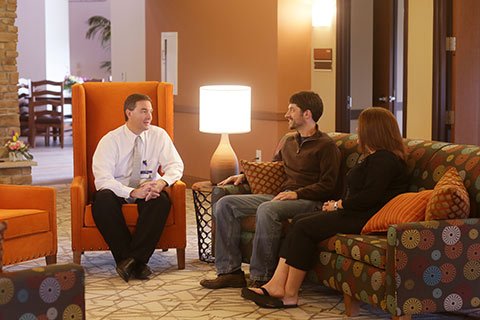Guide to Residential Mental Health Treatment Facilities
If you or a loved one is suffering from mental illness or addiction, contact us for information on our residential treatment programs for mental health in adults.
One in four individuals are living with a mental illness, according to the 2022 National Survey on Drug Use and Health: Mental Health Findings1 conducted by the Substance Abuse and Mental Health Services Administration (SAMHSA). It is a leading health problem in the United States, with approximately 61.5 million adults, or one in four, experiencing a mental illness in a given year.
Among adolescents, the same study found an estimated 20 percent of teens ages 13 to 18, and 13 percent of youth ages 8 to 15, experience a severe mental disorder in a given year.
Another major public health problem, according to the National Institute on Drug Abuse, is drug and alcohol abuse. The Closing the Addiction Treatment Gap (CATG) initiative2, created by the Open Society Institute, reports that 23.5 million Americans, or one in every 10 individuals over the age of 12, are addicted to drugs and/or alcohol.
The statistics bring to the forefront the importance of residential mental health facilities focused on comprehensive assessment and intensive treatment in a residential setting, as one effective tool in treating mental health conditions and addiction, including non-substance addictions like gambling.
But for most people, recognizing a mental illness or an addiction, finding the best help to treat it, and knowing what to expect from a residential treatment center can be an uncertain road without the proper guidance.
Understand more about mental health and addiction treatment within Sibcy House – Adult Residential Treatment Programs for Mental Health.
There is HOPE. For help, call
1-888-537-4229
Recognizing a Mental Health Disorder or Addiction
As with any type of illness, early detection and intervention is key when treating a mental health condition or an addiction. But often times, mental illness or substance abuse may be difficult to recognize because, depending on the severity of the illness, many individuals can still function in their daily lives.
SAMHSA defines mental illness as a health condition that severely changes a person’s behavior, thinking, mood, and/or ability to function, cope, and interact with others.
The most common types of mental illness3 are:
- Anxiety disorders, such as attention deficit/attention deficit hyperactivity disorders (ADD/ADHD), obsessive-compulsive disorder (OCD), post-traumatic stress disorder (PTSD), social anxiety disorder, panic disorder, and generalized anxiety disorder (GAD).
- Depression and other mood disorders, such as bipolar disorder and dysthymia.
- Eating disorders, including anorexia nervosa and bulimia nervosa.
- Schizophrenia.
The National Council on Alcoholism and Drug Dependence, Inc. (NCADD) defines addiction as a complex brain disease that is neurochemically-driven and characterized by long-term chemical changes in the brain that restrict a person’s ability to control behavior, think clearly, and exercise good judgment. People with an addiction need to relieve intense triggers or stress-induced cravings in order to feel normal.
The most common types of addiction4 are:
- Alcohol.
- Prescription drugs, such as OxyContin, Vicodin, pain relievers, stimulants, and depressants.
- Street drugs, with the most commonly used and abused drugs being marijuana, cocaine, ecstasy (MDMA), heroin, steroids, inhalants, methamphetamine, LSD, and phencyclidine (PCP).
Signs of a Mental Health Condition
Each type of mental illness has specific symptoms that exhibit themselves differently in adults, teenagers, and young children. Mental Health America has identified warning signs to look for when determining whether to seek help.
Adult Symptoms:
- Major changes in eating and/or sleeping habits
- Low or lack of energy
- Substance abuse
- Excessive worries, fears, and anxieties
- Feeling like nothing matters
- Inability to cope with daily life problems or perform daily tasks
- Unexplained physical ailments
- Confused thinking
- Depression, such as irritability or sadness, that continues for a lengthy period
- Severe mood swings
- Suicidal thoughts or feeling hopeless or helpless
- Strong feelings of anger
- Social withdrawal
- Delusions, hallucinations, or hearing voices
- Denial of problems
Signs of an Addiction
Casual use of drugs and alcohol can quickly turn to an addiction, with signs and symptoms based on the amount taken and the frequency of use. The Mayo Clinic has identified symptoms and behaviors of drug addiction in adults and teenagers. Other types of addiction have similar warning signs.
Adult Warning Signs:
- Problems at work, such as tardiness, poor performance, or not going to work
- Changes in personality
- Neglecting professional and personal responsibilities
- Unable to deal with problems without taking drugs or having an alcoholic drink
- No longer takes part in interests, hobbies, or activities
- Withdraws from family members and friends, or has strained relationships
- Unable to stop using drugs or drinking alcohol
- Spending money that is not available on drugs and/or alcohol
- Doing things out of character, such as stealing or lying, to obtain drugs or alcohol
- A feeling of needing to use drugs or drink regularly
- Making sure there is a supply of drugs or alcohol on hand
- Having an increased focus and spending a lot of time and energy on obtaining and using drugs and/or alcohol
- Driving or partaking in risky activities while under the influence of drugs or alcohol
- Unable to remember actions while under the influence of drugs or alcohol
- Exhibiting physical signs of drug or alcohol abuse, such as weight loss, upset stomach, loss of consciousness, redness of nose and cheeks, constant runny nose, slurred speech, delayed reflexes, poor balance, bloodshot eyes, etc.
Getting Help at Mental Health Treatment Facilities
Numerous resources are available to individuals who are either personally struggling with a mental illness, addiction, or both, or know someone who is. However, the stigma surrounding these conditions often keep people from seeking help.
A Behavioral Risk Factor Surveillance System (BRFSS) survey5 conducted for The Centers for Disease Control and Prevention (CDC) reveals that only 25 percent of adults with a mental health disorder think people are sympathetic toward those struggling with the illness.
With the Affordable Care Act classifying mental health and addiction services as essential care that mandates health insurance coverage, combined with growing awareness of these illnesses, more people who otherwise would not seek treatment are beginning to do so, according to SAMHSA’s National Survey on Drug Use and Health1, which examines mental health treatment statistics each year.
The Internet has become a helpful starting point for seeking out the right healthcare professional to ensure the right care is given. While an online search is effective in finding local resources and evaluating available options Mental Health America also recommends these starting points:
- Family physician
- State Department of Health, Mental Health Division
- Mental health organizations serving the local area
- Family service or social service agencies
- School or guidance counselors
- Clergyperson
- Marriage or family counselors
- Hotlines or crisis centers
- The SAMHSA Treatment Referral Helpline at 1-877-SAMHSA7 (1-877-726-4727)
Because mental health and addiction professionals specialize in different areas, those seeking help should describe their symptoms or problems during the initial contact. This ensures a referral to a mental health or addiction professional that best matches the illness. This professional could be a doctor, registered nurse, counselor, social worker, therapist, or treatment facility care coordinator.
It’s important for the person seeking treatment to be comfortable with the referral. The first appointment is the ideal time to establish a relationship and learn more about the mental health or addiction specialist. Consider Sibcy House for mental health treatment.
First Appointment Questions to Ask
- What area do you specialize in?
- How long have you been working in the field and what are your credentials?
- What is your philosophy towards addressing mental health disorders and/or addiction problems?
- What is your approach in working with individuals with mental health illness and/or addiction?
- What is the process for assessing the situation and developing a treatment plan?
- What types of treatment are provided and who administers them?
- What are the pros and cons of these treatments?
- How long will treatment be needed?
- Do you accept my insurance plan?
- How much of the treatment(s) cost is covered by my insurance?
How to Cope With a Mental Health Diagnosis
Hearing the diagnosis and letting everything sink in is never easy for anyone involved with a mental illness or addiction. But it’s important to know that many families share similar experiences. To help ease the physical and emotional stress and vulnerability that accompanies a diagnosis, Mental Health America offers these coping tips:
- It’s okay to have feelings of denial or non-acceptance of the diagnosis.
- Work with the specialist to develop a strategy for coping in certain situations, such as handling unusual behavior in public or disruptive actions.
- Establish a support network. This can consist of other family members, friends, or a self-help or support group.
- Seek therapy or counseling for yourself and/or the family.
- Parents or caregivers should schedule time for themselves to relax or pursue their own interests.
- Always remember there is hope and help to assist you.
Determining the Best Treatment for Mental Health
Mental health problems and substance abuse are treated through various forms of treatment programs that are either inpatient, outpatient, or a combination of both. According to Psych Central, the Internet’s oldest and largest independent mental health social network, the type of treatment selected for an individual is based on the:
- Level of care necessary to achieve long-lasting recovery.
- Length of time the person has had the illness or addiction.
Determining the best treatment is a decision made in conjunction with the individual and his or her medical and health professional team. Some factors that help form the decision as to whether outpatient or inpatient care is best include:
- The type of treatment that is best for the individual’s situation.
- The person’s personal circumstances.
- The current physical and mental state of the individual.
- Whether stresses of daily life will interfere with treatment.
- Whether the individual has a strong support system.
- If prior outpatient treatment had been unsuccessful after several attempts.
What Is Outpatient Treatment
Outpatient treatment is mental health or addiction care provided in a setting that does not require a stay in a hospital or treatment facility. Outpatient treatment may be provided during day or evening hours, for one or two hours per visit, on a weekly, biweekly, or monthly basis.
For outpatient care, the individual goes to a facility for treatment, but returns home in the same day, maintaining his or her home, work, and family commitments.
Types of Outpatient Mental Health Treatment Programs
- Mental health services
- Individual counseling
- Individual psychotherapy
- Specialized counseling and therapy for specific behaviors
- Group counseling and therapy
- Pharmacotherapies for addiction
- Process-oriented recovery groups
- Psychoeducational groups
- Psychosocial treatments
- Day treatment through partial hospitalization
- Community-based support groups
- Skills development groups, such as drug or alcohol refusal training, relapse prevention techniques, and stress management
- Medication management
- Family and couples counseling and therapy
- Routine monitoring
What Are Residential Mental Health Treatment Facilities
Contact Lindner Center of Hope for information about our residential treatment center for adults.

Residential mental health facilities are considered inpatient care because they are provided in a residential treatment center where the individual resides for a set amount of time. The settings for residential treatment facilities vary greatly, including campus-based in peaceful or wilderness settings, halfway houses, psychiatric-style hospitals, boarding schools, and group homes.
According to the American Academy of Child Adolescent Psychiatry, residential mental health facilities are most helpful for people who:
- Were unsuccessful with outpatient treatments.
- Need intensive treatment after receiving inpatient psychiatric care.
- Have education needs that a less restrictive setting cannot meet.
Residential treatment centers offer:
- Comprehensive diagnostic evaluations.
- A safe and secure live-in environment where individuals can focus entirely on their recovery.
- An on-site, multidisciplinary team offering highly individualized services and treatment programs.
- Evidence-based treatment focused on integrated and interdisciplinary care.
- A therapeutic community providing the emotional support needed to get well.
- The ability to build or rebuild life skills.
Types of Residential Mental Health Treatment Facilities
- Acute crisis care
- Short-term intensive treatment for adolescents and adults
- Specialty programs
- Women’s mental health programs
- Maintenance and wellness programs
- Psychoeducational groups
- Behavioral management
- Transcranial magnetic stimulation for treatment of depression
- Psychotherapy
- Cognitive behavioral therapy (CBT) for a wide variety of mental health disorders
- Dialectical behavioral therapy (DBT) to treat personality and behavioral disorders, depression and chronic suicide
- Drug therapy to treat certain emotional or mental disorders
- Psychoanalysis
- Electroconvulsive therapy for treatment of certain psychiatric disorders
- Detoxification services for drug and alcohol addiction
- Partial hospitalization for adolescents and adults
- Movement, art, and music therapy for emotional disorders
- Medication management
- Group therapy
- Peer-cultural groups and activities
- Supported employment programs
- Family education programs, provided evenings or weekends
- After treatment support
Choosing the Right Residential Treatment Center for Mental Health and Addiction
Selecting a residential treatment center is a very personal decision. According to Children and Adults with Attention-Deficit/Hyperactivity Disorder (CHADD), the residential mental health facility selection should be based on the level of care needed and location preferences. If you’re unsure if residential treatment is the right option, you can find more information here.
The best approach is to comprise a list of potential residential treatment centers that match the person’s needs. Recommendations via word-of-mouth, primary physician, mental health and addiction specialists, other families who have used residential mental health facilities, advocacy organizations, and online research are all good sources when comprising a list.
Other considerations are the type and focus of the treatment facility. For example, while numerous inpatient facilities treat all types of mental health disorders and addiction problems, some may specialize solely in treating drug abuse or alcohol addiction, while others may focus only on mental health disorders.
Likewise, residential treatment centers may cater to different ages (i.e., youth, teenagers, or adults), or be gender-specific.
Location is also an important consideration, especially if the treatment center requires or encourages frequent family visits or a participation commitment from parents, spouses, or family members.
On the other hand, out-of-state treatment can be an excellent option for those looking to get away from a challenging environment and focus 100% on treatment.
A Typical Day in a Residential Treatment Center
Structure is key to recovery, so a weekly schedule in a residential mental health treatment center focuses on providing a holistic approach that is organized through blocks of activities. An informal, online survey6 of residential mental health facilities finds that each day follows a scheduled routine, with activities provided in hour-based blocks following breakfast, lunch, and dinner.
Although an individual’s daily schedule will vary based on the focus of treatment being provided, the following outline depicts a typical day’s activities:
- Individual and group therapy sessions, such as cognitive and dialectical behavioral therapies, proper nutrition advice, anxiety and trauma coping methods, relapse prevention skills, and living skills.
- Individual appointments with specialists, as needed.
- Fitness and recreational activities
- Spiritual enrichment
- Personal time for meditation, reflection, or individual treatment assignments
Checklist of What to Look for in an Inpatient Residential Mental Health Facility
- Accreditation. This information is available from The Joint Commission, The Commission on Accreditation of Rehabilitation Facilities.
- State license. Typically from the Department of Health in the state the facility is located.
- Location. This should meet the preferences of the individual and offer the necessary treatment programs.
- The setting. It should be clean and comfortable, and the individual should feel comfortable within the environment.
- Organization of the center. Inquire as to whether patients are segregated by groups according to their mental health or addiction illness, or if everyone is together.
- Philosophy of treatment.
- Types of treatment programs provided.
- Methods of delivering treatment programs. The methods should be supported by research.
- The manner in which treatment results are measured. Generally, monitoring, assessments, and measured outcomes are utilized.
- Discipline policy. This should include discipline methods used and established policies on the use of restraints and seclusion.
- Composition of therapy groups. Inquire about number of people in any one group and whether groups are divided by illness type.
- Admission process. Some centers offer a free initial screening and assessment. Find out more information on what psychological assessment is here and why it is a critical step of the process.
- Average length of a residential stay. Ask how the length of stay is determined and by whom.
- Staff qualification requirements, including background checks.
- Staff turnover rate.
- Ratio of staff to residents.
- A 24/7 on-site medical staff and nurses.
- The daily schedule. This gives an overview of activities that complement treatment and therapy programs.
- Types of updates provided to family members, if any. Some facilities have liaisons to update family members and answer any questions they may have.
- Drop-in policy for visitors. Inquire about visitor guidelines and whether visits are supervised or unsupervised.
- Any formal complaints made against the residential treatment center and their outcomes.
- Cost. Check to see how much is covered by insurance and whether financial assistance is available.
- Aftercare approach. Typically, residential treatment centers offer at least a year of some form of aftercare, such as self-help groups or outpatient therapy.
- Provides referrals of past and current residents to speak with about the residential treatment center and its programs.
Do Residential Treatment Programs Work?
Numerous studies on different treatment approaches show that structured programs provided by residential treatment centers are effective for youth and teens with behavioral problems, and individuals with a long history of addictive behavior.
For example, a review of studies8 conducted on residential treatment centers for co-occurring mental illness and substance abuse disorders by the Dartmouth Psychiatric Research Center and Dartmouth Medical School concludes that residential programs provide greater integration of treatments and support services.
Additional research published in the Journal of Child and Family Studies9 finds that residential treatment centers provide long-term effectiveness for children with severe mental health issues.
While research supports the effectiveness of residential treatment programs, each individual is different and treatment outcomes are likely to vary based on the individual’s specific circumstances.
Why is Mental Health Treatment Necessary?

Just about any illness requires some type of treatment, whether it’s an over-the-counter medicine, surgery, or therapy. And with many illnesses, not getting the proper treatment could have dire consequences. Such is the case with mental health and substance abuse illnesses.
According to SAMHSA, people living with mental health and addiction disorders who do not receive treatment are at risk for:
- Chronic medical conditions;
- Premature death;
- A life of poverty;
- Social isolation;
- Dropping out of school;
- Trauma;
- Smoking;
- Obesity;
- Other substance use;
- Incarceration.
In addition, mental illness and addiction conditions left untreated can be costly on society. The National Alliance on Mental Illness (NAMI) reports that serious mental illness costs the U.S. $193.2 billion in lost earnings each year.
Mental Health Recovery Expectations

As NAMI points out, recovery is a process, not an event. Furthermore, the recovery journey is different for each individual.
Naturally, recovering individuals and people they live or associate with may have questions and concerns about what to expect from recovery. NAMI provides helpful guidance by outlining some recovery expectations:
- Expect individuals recovering from a mental illness or addiction to live productive and fulfilling lives with medication and support services. However, don’t expect them to return to the same type of life as before.
- Expect the use of coping strategies to manage their illness.
- A relapse is always a possibility, but it can be prevented by recognizing patterns, signs and symptoms of the illness so timely care can be sought.
- Expect the individual to take responsibility for his or her recovery.
- In some cases, expect treatment to be continuous.
- Expect recovery to be a holistic approach that encompasses both physical and mental health.
According to Rethink, the leading national mental health membership charity, recovery encompasses two parts:
Clinical Recovery – the use of treatment and methods to eliminate or manage symptoms to enable social functioning.
Personal Recovery – developing a positive identity by changing an individual’s feelings, attitudes, values, skills, goals, and/or roles in order to enjoy a satisfying life within the limitations of the illness.
There is HOPE. For help, call
1-888-537-4229
Sources
- Substance Abuse and Mental Health Services Administration. “Results from the 2012 National Survey on Drug Use and Health: Mental Health Findings.” December 2013.
- Open Society Foundations Closing the Addiction Treatment Gap (CATG) initiative. “Defining the Addiction Treatment Gap.” November 2010.
- SAMHSA’s Resource Center to Promote Acceptance, Dignity and Social Inclusion Association with Mental Health (ADS Center). “Facts About Common Mental Illnesses.”
- National Council on Alcoholism and Drug Dependence, Inc. “Alcohol & Drug Information.”
- Centers for Disease Control and Prevention. “Attitudes Toward Mental Illness – 35 States, District of Columbia, and Puerto Rico, 2007.” Morbidity and Mortality Weekly Report, May 28, 2010: 59(20); 619-625.
- Informal, online survey of residential treatment centers’ daily schedules, typical day web pages: Lindner Center of Hope, Hazelden, Betty Ford Center, Timberline Knolls.
- Bilchik, Shay. “Residential Treatment: Finding the Appropriate Level of Care.” CWLA Residential Group Care Quarterly, Summer 2005.
- Brunette, M., Mueser, K., & Drake, R. “A Review of Research on Residential Programs for People With Severe Mental Illness and Co-Occurring Substance Use Disorders.” Drug and Alcohol Review, December 2004: 23, 471-481.
- Preyde, M., Frensch, K., Cameron, G., White, S., Penny, R., & Lazure, K. “Long-Term Outcomes of Children and Youth Accessing Residential or Intensive Home-Based Treatment: Three Year Follow Up.” Journal of Child and Family Studies, 2001: 20 (5), 660-668.

